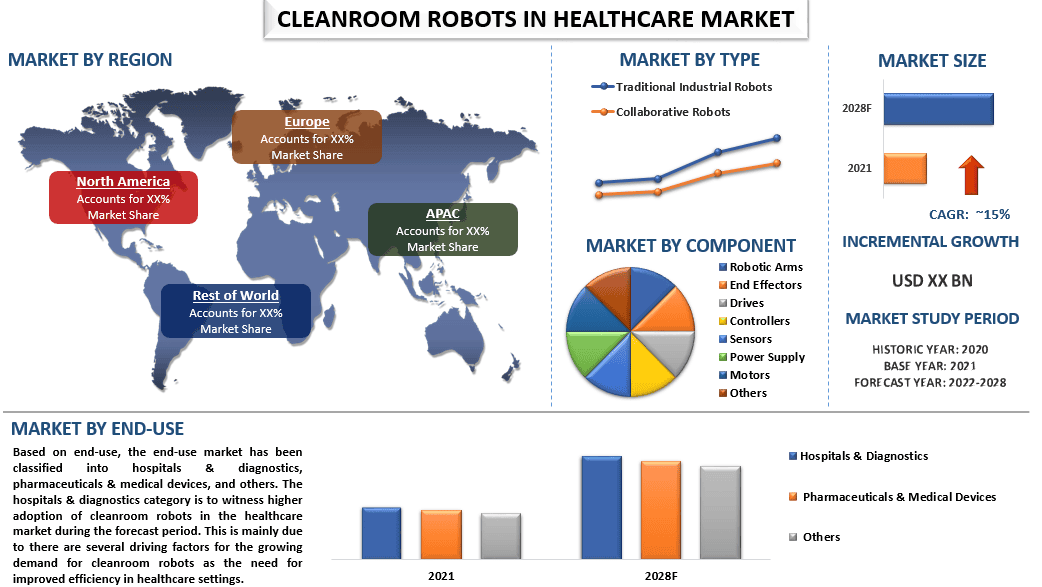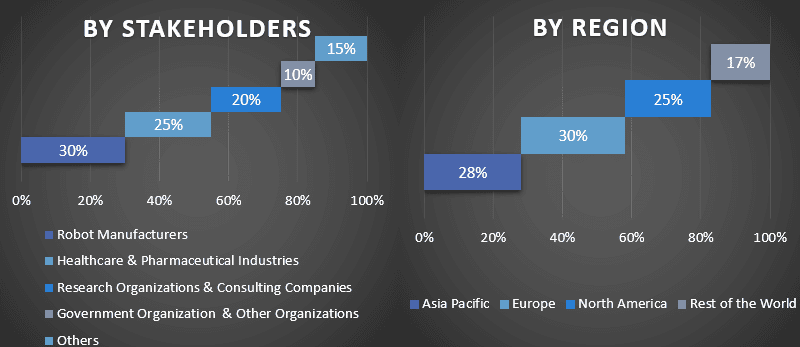- Home
- About Us
- Industry
- Services
- Reading
- Contact Us
Cleanroom Robots In Healthcare Market: Current Analysis and Forecast (2022-2028)
Emphasis on Type (Traditional Industrial Robots and Collaborative Robots); Component (Robotic Arms, End Effectors, Drives, Controllers, Sensors, Power Supply, Motors, and Others); End-Use (Hospitals & Diagnostics, Pharmaceuticals & Medical Devices, and Others); and Region/Country

The global cleanroom robots in healthcare market is expected to grow at a significant rate of around 15% during the forecast period. Cleanroom robots are a vital technology used in healthcare environments to maintain sterility and cleanliness. These robots have been designed to operate in sterile environments, where even the slightest contamination can have serious consequences. The use of cleanroom robots in healthcare is becoming increasingly popular due to their ability to perform tasks that would otherwise be impossible or difficult for humans.
Cleanroom robots in healthcare market is a rapidly growing sector, with the market expected to continue its growth over the coming years. The market is being driven by the increasing demand for high-quality healthcare services, coupled with the need to maintain strict levels of hygiene and sterility in healthcare environments. The need for automation to perform tasks such as disinfection, sterilization and material handling in healthcare facilities is also driving the market. Also, with the rising product development and technological advancements in technology, and the increasing number of companies entering the market, the market is expected to continue growing in the coming years. For instance, a new product development of Cleanroom Robots is the Omron LD UVC Series of autonomous mobile robots, launched by Omron Automation in 2021. The Omron LD UVC Series is designed to provide efficient and effective disinfection in cleanroom environments.
ABB, DENSO CORPORATION; FANUC CORPORATION; Kawasaki Heavy Industries, Ltd.; KUKA AG; Mitsubishi Electric Corporation; NACHI-FUJIKOSHI CORP; OMRON Corporation; Seiko Epson Corporation; YASKAWA ELECTRIC CORPORATION. are some of the key players in the market. Several M&As along with partnerships have been undertaken by these players to facilitate customers with hi-tech and innovative products/technologies.
Insights Presented in the Report
“Amongst type, collaborative robots category to witness robust CAGR during the forecast period”
Based on type, the market is segmented into traditional industrial robots and collaborative robots. Among them, the collaborative robots category is to witness a higher CAGR during the forecast period. Collaborative robots, also known as cobots, have gained popularity in recent years due to several driving factors such as cost-effectiveness, flexibility, safety, shorter implementation time, and the ability to improve quality and productivity. As more businesses seek to optimize their operations and remain competitive, collaborative robots are likely to play an increasingly important role in the healthcare industry.
“Amongst component, the 4WD to hold a significant share in the market in 2021”
On the basis of component, the market is categorized into robotic arms, end effectors, drives, controllers, sensors, power supply, motors, and others. Among these, the end effectors held a significant share of the market in 2021. This is mainly due to the end effectors being focused on precision, customization, durability, safety, adaptability, and integration with other systems. As the demand for cleanroom robots continues to grow, we can expect to see further innovation in end effector design to meet the specific needs of the healthcare industry and other sectors that require a cleanroom environment.
“APAC to hold the fastest growth in the market”
For a better understanding of the market adoption of cleanroom robots in healthcare industry, the market is analyzed based on its worldwide presence in the countries such as North America (U.S., Canada, Rest of North America), Europe (Germany, U.K., France, Spain, Italy, Rest of Europe), Asia-Pacific (China, Japan, India, Rest of Asia-Pacific), Rest of World. APAC to hold the fastest growth in the market during the forecast period owing to the presence of well-established healthcare sectors of developing countries such as China and India, which can be attributed to various factors, including a rise in the number of healthcare providers, increasing demand for unmet healthcare services, a thriving economy, and a constantly improving healthcare infrastructure. Moreover, the government’s supportive measures towards robotics and AI-based solutions, along with higher adoption of robotics in the healthcare sector, are driving market growth in the region.
Reasons to buy this report:
- The study includes market sizing and forecasting analysis validated by authenticated key industry experts.
- The report presents a quick review of overall industry performance at one glance.
- The report covers an in-depth analysis of prominent industry peers with a primary focus on key business financials, product portfolio, expansion strategies, and recent developments.
- Detailed examination of drivers, restraints, key trends, and opportunities prevailing in the industry.
- The study comprehensively covers the market across different segments.
- Deep dive regional level analysis of the industry.
Customization Options:
The global cleanroom robots in healthcare market can further be customized as per the requirement or any other market segment. Besides this, UMI understands that you may have your own business needs, hence feel free to connect with us to get a report that completely suits your requirements.
Table of Content
Research Methodology for the Cleanroom Robots In Healthcare Market Analysis (2022-2028)
Analyzing the historical market, estimating the current market, and forecasting the future market of the global cleanroom robots in healthcare market were the three major steps undertaken to create and analyze the adoption of cleanroom robots in healthcare in major regions globally. Exhaustive secondary research was conducted to collect the historical market numbers and estimate the current market size. Secondly, to validate these insights, numerous findings and assumptions were taken into consideration. Moreover, exhaustive primary interviews were also conducted, with industry experts across the value chain of the global cleanroom robots in healthcare market. Post assumption and validation of market numbers through primary interviews, we employed a top-down/bottom-up approach to forecasting the complete market size. Thereafter, market breakdown and data triangulation methods were adopted to estimate and analyze the market size of segments and sub-segments of the industry pertains to. Detailed methodology is explained below:
Analysis of Historical Market Size
Step 1: In-Depth Study of Secondary Sources:
Detail secondary study was conducted to obtain the historical market size of the cleanroom robots in healthcare market through company internal sources such as annual reports & financial statements, performance presentations, press releases, etc., and external sources including journals, news & articles, government publications, competitor publications, sector reports, third-party database, and other credible publications.
Step 2: Market Segmentation:
After obtaining the historical market size of the cleanroom robots in healthcare market, we conducted a detailed secondary analysis to gather historical market insights and share for different segments & sub-segments for major regions. Major segments are included in the report as type, component, and end-use. Further country-level analyses were conducted to evaluate the overall adoption of testing models in that region.
Step 3: Factor Analysis:
After acquiring the historical market size of different segments and sub-segments, we conducted a detailed factor analysis to estimate the current market size of the Cleanroom Robots In Healthcare Market. Further, we conducted factor analysis using dependent and independent variables such as various type, component, and end-uses of cleanroom robots in healthcare. A thorough analysis was conducted for demand and supply-side scenarios considering top partnerships, mergers and acquisitions, business expansion, and product launches in the cleanroom robots in healthcare market sector across the globe.
Current Market Size Estimate & Forecast
Current Market Sizing: Based on actionable insights from the above 3 steps, we arrived at the current market size, key players in the global cleanroom robots in healthcare market, and market shares of the segments. All the required percentage shares split, and market breakdowns were determined using the above-mentioned secondary approach and were verified through primary interviews.
Estimation & Forecasting: For market estimation and forecast, weights were assigned to different factors including drivers & trends, restraints, and opportunities available for the stakeholders. After analyzing these factors, relevant forecasting techniques i.e., the top-down/bottom-up approach were applied to arrive at the market forecast for 2028 for different segments and sub-segments across the major markets globally. The research methodology adopted to estimate the market size encompasses:
- The industry’s market size, in terms of revenue (USD) and the adoption rate of the cleanroom robots in healthcare market across the major markets domestically
- All percentage shares, splits, and breakdowns of market segments and sub-segments
- Key players in the global cleanroom robots in healthcare market in terms of products offered. Also, the growth strategies adopted by these players to compete in the fast-growing market
Market Size and Share Validation
Primary Research: In-depth interviews were conducted with the Key Opinion Leaders (KOLs) including Top Level Executives (CXO/VPs, Sales Head, Marketing Head, Operational Head, Regional Head, Country Head, etc.) across major regions. Primary research findings were then summarized, and statistical analysis was performed to prove the stated hypothesis. Inputs from primary research were consolidated with secondary findings, hence turning information into actionable insights.
Split of Primary Participants in Different Regions

Market Engineering
The data triangulation technique was employed to complete the overall market estimation and to arrive at precise statistical numbers for each segment and sub-segment of the global cleanroom robots in healthcare market. Data was split into several segments & sub-segments post studying various parameters and trends in the areas of type, component, and end-use in the global cleanroom robots in healthcare market.
The main objective of the Global Cleanroom Robots In Healthcare Market Study
The current & future market trends of the global cleanroom robots in healthcare market were pinpointed in the study. Investors can gain strategic insights to base their discretion for investments on the qualitative and quantitative analysis performed in the study. Current and future market trends determined the overall attractiveness of the market at a regional level, providing a platform for the industrial participant to exploit the untapped market to benefit from a first-mover advantage. Other quantitative goals of the studies include:
- Analyze the current and forecast market size of the cleanroom robots in healthcare market in terms of value (USD). Also, analyze the current and forecast market size of different segments and sub-segments
- Segments in the study include areas of type, component, and end-use.
- Define and analysis of the regulatory framework for cleanroom robots in healthcare
- Analyze the value chain involved with the presence of various intermediaries, along with analyzing customer and competitor behaviors of the industry.
- Analyze the current and forecast market size of the cleanroom robots in healthcare market for the major region.
- Major countries of regions studied in the report include Asia Pacific, Europe, North America, and the Rest of the World.
- Company profiles of the cleanroom robots in healthcare market and the growth strategies adopted by the market players to sustain in the fast-growing market
- Deep dive regional level analysis of the industry
Related Reports
Customers who bought this item also bought










